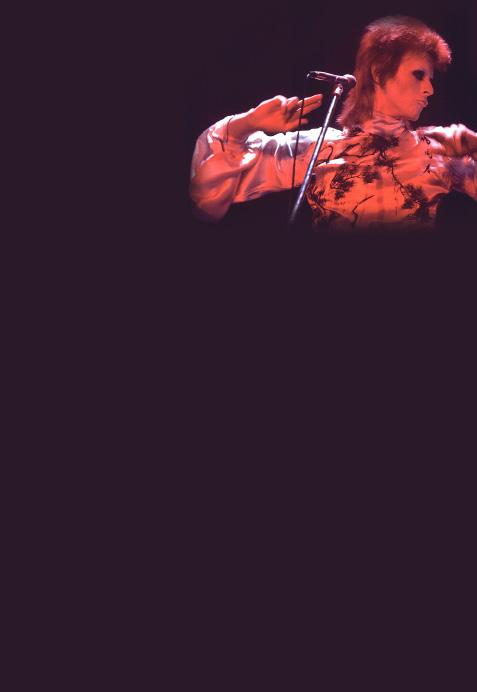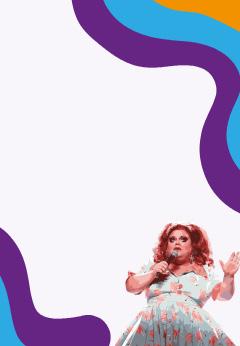
8 minute read
THE STARMAN: DAVID BOWIE’S ICONIC ZIGGY
THE STARMAN: DAVID BOWIE’S ICONIC ZIGGY STARDUST
David Bowie was well known for his extravagant and innovative music style, hailing from Brixton the singer-songwriter was an act so fresh to the scene, he captured people’s attention and changed music as we know it. Part of his brand was having personas - Aladdin Sane being one of the most established acts, including Ziggy Stardust, Major Tom and Thin White Duke being amongst the most iconic fictional characters. Bowie wanted to change the music industry that he thought was too boring. This expressive industry is for individuals and groups to sing and write about personal experiences and taboo subjects.
Advertisement
Ziggy Stardust, the man from Mars, was concocted for Bowie’s 1972 concept album The Rise and Fall of Ziggy Stardust and fitted in with his backing band ‘Spiders from Mars’. The character was inspired by an encounter Bowie had with British rocker Vince Taylor who, after many years in the industry claimed to be a messianic figure sent from space; yes an alien messiah. After his meeting with Taylor, Bowie was struck with inspiration and spent months creating Ziggy Stardust, who’s name he took from a barber’s he saw from a train window. The story was that the earth had five years left until destruction and Ziggy Stardust and his band were sent to warn everyone of the natural disaster.
Despite Ziggy being one of Bowie’s most recognisable personas he is frequently mistaken for the lightning bolt symbol, which was in fact the symbol for Aladdin Sane. The look was one of the most striking appearances in all of the industry, with a gold circle slap bang in the middle of his forehead and copious amounts of eyeliner and electric blue eyeshadow not only was the music and theatre industry changed, but the fashion industry too. Bowie made everyone look, listen and stare at the gorgeous magnificent spectacle he had put out there. The 70s really was just Bowie’s world. On stage Ziggy was enigmatic. Many of the records explicitly featuring Ziggy such as Life on Mars and Space Oddity were more low-fi and acoustic. However, the persona and performance were less of a live music experience and more of an artistic movement. The more rambunctious tracks later on in Bowie’s career such as ‘Let’s Dance’ and ‘Modern Love’ of course proved to be groundbreaking, but nothing reached the heights of Bowie’s freshmen albums and characters. This alter-ego of Bowie’s changed rock phenomenally, lighting that theatrical flare that has since been echoed in every corner of the music and film industry. Not only did it create a new era for rock music, it was also an extremely defining moment for Bowie’s career. Ziggy was a song cycle so tightly and impeccably tailored together, it set out a visionary direction for pop music setting a new standard for rock and roll music, whilst delivering his synthetic ideal with campy sex appeal and raw power. Emerging on stage in outrageous shoulder pads and bodysuits, his stage presence was altered forever. Sadly Ziggy was short lived and after twelve months of rigorous maintenance Bowie retired the persona in 1973 as the lines began to blur, convincing some fans that Ziggy was actually there to save the world.
After that there was a fear Bowie would never return to the music scene and that the Brixton born genius had quit the music business for good. However, Bowie would return of course with new personas and new music and new characters. But with Aladdin Sane, Halloween Jack and Thin White Duke getting their time in the spotlight none would ever resonate quite like Ziggy Stardust did.
OLIVIA DELLAR
Lip-Syncing Legacy: Deceitful Controversy or a Faithful Experience?
In the modern era, lip-syncing is all around us, changing the face of what it means to be “live”. From battles on RuPaul’s Drag Race and Lip Sync Battle to controversial concerts and “failed” live performances, it’s both the bane and boon of the live industry. Equally celebrated and shunned, the original lip-syncing legacy extends from the 1960s to current days and has been at the forefront of many performances, bringing about important questions: “does lip-syncing fail to give authenticity” or “and does lip-syncing mar the audience’s experience”?
While some musicians don’t sound as good as they do on record, others sound better, but what trumps the whole experience is the authenticity that “live” aspects bring to a concert. Yet, lip-syncing is always cropping to audience anger when used as dishonest means and it’s even caused controversy for artists who have wanted to sing live but have been expected to lip-sync.
Look at the Top of the Pops in the 80s where musicians were expected to lip sync and mime rather than perform live. It wasn’t until the infamous 1991 performance from Nirvana which saw the performance of their song ‘Smells Like Teen Spirit’ deliberately messed up in a statement against the show’s faked “live” aspect. In a performance that sees frontman, Kurt Cobain, lifelessly strumming a guitar in a mechanically fake way or the onstage carnage that ensues when audience members disrupt the performers as the song continues playing unabated; Nirvana’s statement against lip-syncing was remarkably clear as ruining an experience, not just for audience members but for musicians as well. It established lip-syncing as a faithless legacy that felt fraudulent and more importantly fake, and had no comfortable place within the music industry, or at least if it was the main proprietor of a live performance.

However, a famous musician caught in the complication of lip-syncing was none other than Michael Jackson, leaving many people unsure of how far the “dishonesty” of lip-syncing stretched. Anyone who saw Michael Jackson in his prime often revelled in the spectacle of his concerts with bombastic dance numbers, killer vocals, and allround great performances. However, a prevalent fact remained that Jackson often favoured lipsyncing during songs like ‘Billie Jean’ where the dance routines were too demanding to be able to provide vocals in a competent way. While at first, it seems like exploiting the audience, in actuality, one has to wonder if there was a valuable trade-off. Jackson would always sing live during his ballads (which often dominated most of his concerts) and never performed whole concerts using lip-sync. When the truth was revealed, some argued it marred the experience while others saw it as a worthy trade-off; a Michael Jackson concert wasn’t just about the singing but about the whole experience, something that Jackson delivered expertly on.
Lip-syncing is vast and complicated, predominantly hated when used without the audience’s knowledge and often loved when used as a riff to greater things. It’s had a long history and this article only scratches at the surface of its legacy, but one fact remains: lip-syncing is here to stay. SAM PEGG
The Battle of The Drag Queens: Lip-Sync Edition
Ginger Minj vs Jaidynn Diore Fierce In a tense moment of season 7, the makeover challenge called for the remaining queens to add an eliminated queen to their drag family. This challenge saw Ginger Minj and Jaidynn Diore Fierce battle it out in the bottom. However, this was a lipsync like no other, with the queens being physically attached to the other queens they made over.The Ginger/Sasha Belle and Jaidynn/Tempest DuJour combos battled it out to Tiffany’s ‘I Think We’re Alone Now,’ which is in itself a high-quality joke. The actions on the main stage reflected the comedy set up, with Ginger Minj cutting her very shoddy, breast connection with her sister, while Jaidynn was left attempting to disco dance with a very tall person with their crotch attached to her butt. In some antics that would often look a bit messy, Ginger’s broken costume and wigless head beat Jaidynn’s splash of Sunday Night Fever, ending her few weeks in the bottom and giving more reason for season 7 to get a lot more respect than it usually does.
EMILY DENNIS

Coco Montrese vs Alyssa Edwards The epic rivalry between Coco Montrese and Alyssa Edwards came to head in the most epic lip-sync in RuPaul’s Drag Race herstory. In season 5, episode 9 - we see Coco and Alyssa lip-sync to Paula Abdul’s ‘Cold Hearted’. It is full of stunning moments and epic moves as the queens use their feud to light up their performance. Alyssa does a helicopter spilt, is that even legal? And prances around the stage proving just why she is the dancing queen, whilst Coco swirls in her epic yellow outfit which is eyedropping. But the most epic moment is when Coco points to her mouth whilst lip-syncing to the rapid paced almost rap-like lyrics. They both prove why they are lip-syncing assassins making all our jaws drop to the floor. If there is any lip-sync I would recommend for someone to watch it’s this one! It encapsulates everything there is to drag from drama to extraordinary performances, even after 7 years of the performance being available to watch I am still gagged to this day each time I watch it.
MORGAN MCMILLAN
Aja vs Nina Bo-Nina Brown When people think of ‘best drag race lip syncs’ they sadly don’t always bring up the ICONIC season 9 battle that was Aja vs. Nina Bo-Nina Brown. Although often outshone by the other lip syncs of the season (see rose wig and ‘can I keep it on please?’), I think this lip sync deserves due credit. It has DRAMA, SKILL, and most importantly, is massively entertaining. The girls hit every beat of the song, despite them going about it in wildly different styles: Aja vogues and splits and flips, whereas Nina utilises her huge wig and pads, duckwalking across the floor and giving us FACE. I’ve also got to shout out the other girls going wild in the background: I love a good lip sync where you can tell the live audience (the other queens) are having fun too, as told by Shea’s excited call of ‘Come on ladies let’s go!!’ and Trinity’s exhilarated jumps as the girls hit the same move at the same time. It’s one of those lip syncs that just feels so alive, like the girls are having a great time whilst doing it. Not to mention, the song (‘Finally’ by CeCe Peniston) is an absolute banger.










